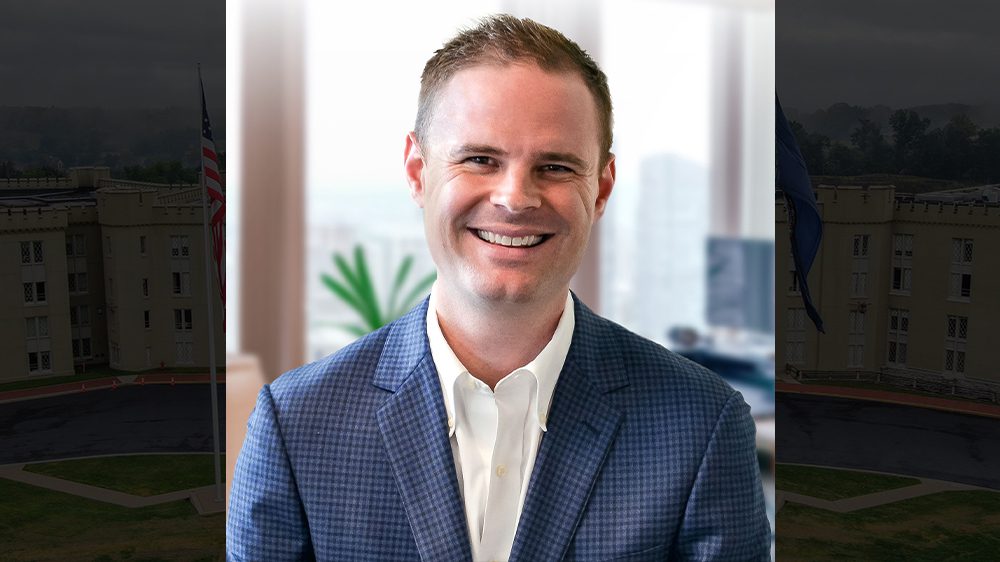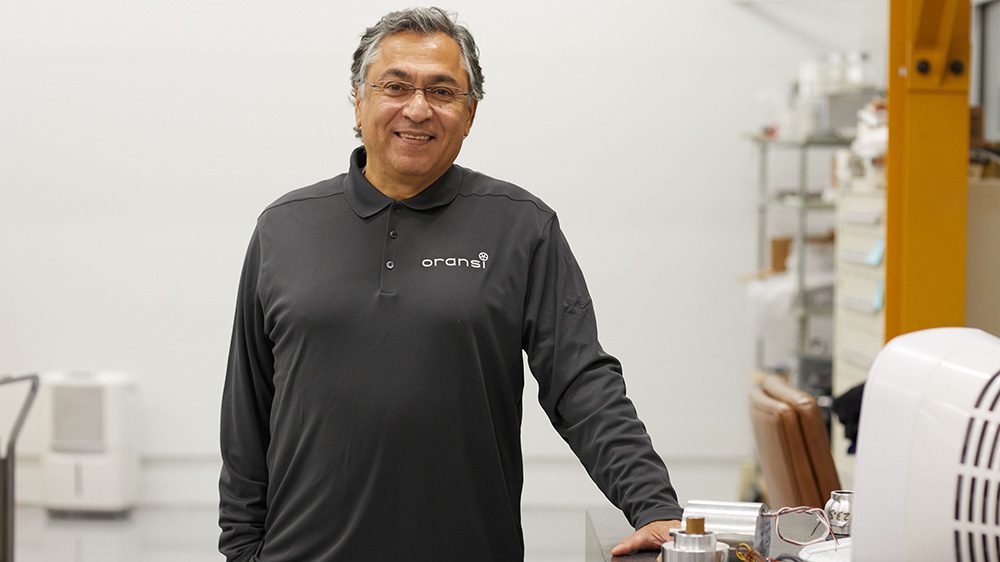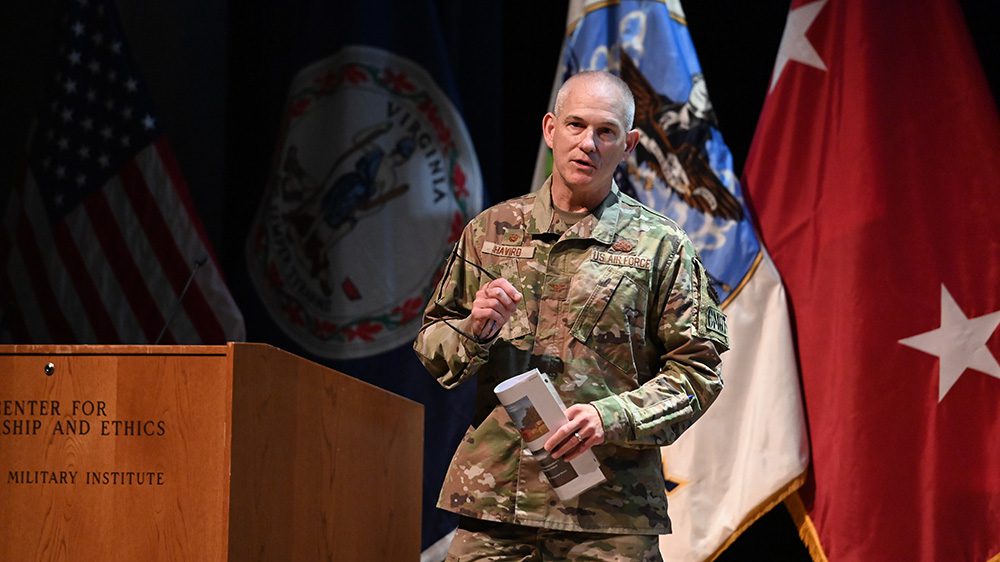In March 2020, the commander of Carrier Air Wing 17 offered Keilty the position as the wing’s landing safety officer. Keilty, who had twice been a squadron LSO, accepted and was deployed in support of three operations. “I especially liked being the wing LSO,” he recalled. “It is a distinct job in that you are responsible to only two people: The air wing commander and the carrier’s captain. Bringing aircraft and their crews safely aboard is a great responsibility,” he said, “and I was now responsible for every aircraft in the wing.” When he completed the tour in 2021, he received the prestigious Commander John “Bug” Roach LSO of the Year Award for the entire U.S. Navy. In April 2021, he joined VFA 211 for his department head tour and made a 10-month deployment to the Mediterranean.
In early 2023, a fellow aviator urged him to reapply to the Blue Angels. While his career had been satisfying and successful, he thought, “Why not put a bow on it?” This time, he was successful. “It was a huge surprise,” he remembers. “Again, I was more senior in rank than the aviators the squadron usually chooses.” That difference was enhanced when, during his initial training, he was selected for early promotion to commander—the same rank as the squadron’s commanding officer—which he pinned on in October 2024.
Asked what struck him upon reporting to the Blue Angels in late 2023, Keilty said, “The fact that we represent the 800,000 active-duty and reserve sailors and Marines. For thousands of people, we are the only representatives of the sea services they ever see firsthand—and so we are determined to do our very best at all times.”
The squadron’s schedule is demanding. During its 2024 season, which started in March, it performed hundreds of times, including 64 public demonstrations in 32 cities across the United States. Between these demonstrations, the squadron’s aviators conduct “outreach,” e.g., visiting schools and hospitals. They have one day off—Mondays—and practice daily, sometimes multiple times a day. “Practice is essential to our success and, more important, safety,” explained Keilty. “Flying, especially the precise flying we do, is like any other performing art. You must keep the reps up to keep your skills sharp.”
There is a mental element to it, as well, says Keilty. “We document every demonstration and every practice session and then review it closely. We also have a thorough briefing and debriefing. Throughout, we stress the need to be honest with each other and ourselves about how we can improve. That builds trust among us, and then we build on that trust.” A high level of mutual trust is essential, considering the demands of the demonstrations. For example, when in the famous Blue Angels “diamond formation,” four aircraft are conducting intricate maneuvers with separations often as close as 18 inches.
Flying for the Blue Angels is physically demanding. During the practice sessions and the 45-minute demonstrations, the pilots do not wear the customary “g-suit,” the garment worn by pilots to counter the effects of high levels of acceleration force (or “G-force”).
“It is essential, therefore, that we are physically fit. So, we follow a strict workout regimen to strengthen our legs and core.”
A unique aspect of the control system in the aircraft that the Blue Angels fly demands the pilots also develop their biceps and forearms. “The Super Hornet is a fly-by-wire aircraft, meaning it doesn’t take much pressure on the stick to maneuver,” he explained. “But the nature of what we do demands a precise feel on the stick. So, there is a weighted spring exerting 45 pounds of forward pull on the control stick when we fly.”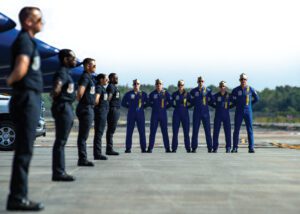
Keilty says there are other challenges. “If you have a tough flight, you cannot let that distract you from being a good representative of the squadron and, as I alluded to earlier, the Navy and the Marines. Put another way, having an off day in the cockpit doesn’t mean you can have an off day on the crowd line after a show or during a school visit.”
“You spend a lot of time away from your family. I am fortunate that my wife, Mekele, and children are thoroughly invested in the experience. They are proud of the entire team and love being around it.”
Although the aviators are the “face” of the Blue Angels, the support staff is essential to the squadron’s success. “All the people and the equipment we need travel with us because we often are far from a naval air station. Furthermore, a normal strike fighter squadron has 240 personnel; we have 160, only 60 of whom travel to each show site. So, the people who keep us flying often work very long hours.” What do the people on the support team have in common? “They are highly motivated and have an irrepressible ‘can-do’ attitude. Let’s say we need a part that is hundreds of miles away. The crew of the squadron’s C-130J transport, ‘Fat Albert,’ won’t hesitate to fly overnight to get it. Those guys are my heroes.”
As to the Blue Angels “off-season,” Keilty explained, “We really don’t have one. After we return to Pensacola, we keep flying because we can’t let our skills atrophy.”
“It is important that we maintain a strong institutional memory,” he continued. “So, usually, two or three of the pilots will leave at the end of the season. The rest will welcome the new aviators, and the 2025 Blue Angels will begin to take shape.”
How does that happen? “We start with the basics and then take 10 days off at Christmas. On Jan. 4, we head to El Centro Naval Air Facility in California, where we are unaccompanied by families and 100% focused on preparing for the season. We fly two or three times a day, 6 days a week. To give you an idea of how intense that is, if I were with a squadron in the fleet, I’d fly on average 20 times a month.”
This schedule is necessary because the new season begins in early March. “In that short time, we have to build the skills, trust, and confidence we need to operate successfully and safely.” This year, Keilty also will be an instructor. “We’ll have a new boss who flies Blue Angels Number 1. When I arrived, the commanding officer taught me, the new Blue Angels Number 2, the ropes. Now, it’s my turn to teach boss.”
What’s next for Keilty? “This will be my final season. The Navy and the Marine Corps usually cap tours at 2 years.” In late November 2025, Keilty will depart Pensacola. He’ll return to the fleet in July 2026 as the executive officer of (VFA) 25 and take command of the squadron in fall 2027.
Keilty concluded by bringing things back to the Institute. “I cannot thank Tom Mortenson and many others enough for seeing something in me and giving me a shot at being a cadet. My cadetship was fundamental to my success. VMI gave me a vector that I have followed since I was in barracks. I tell high school students that anything they want to do starts with a goal. VMI provides the structure and the opportunities that give people of strong character, drive, and ambition every chance to reach their goals.”
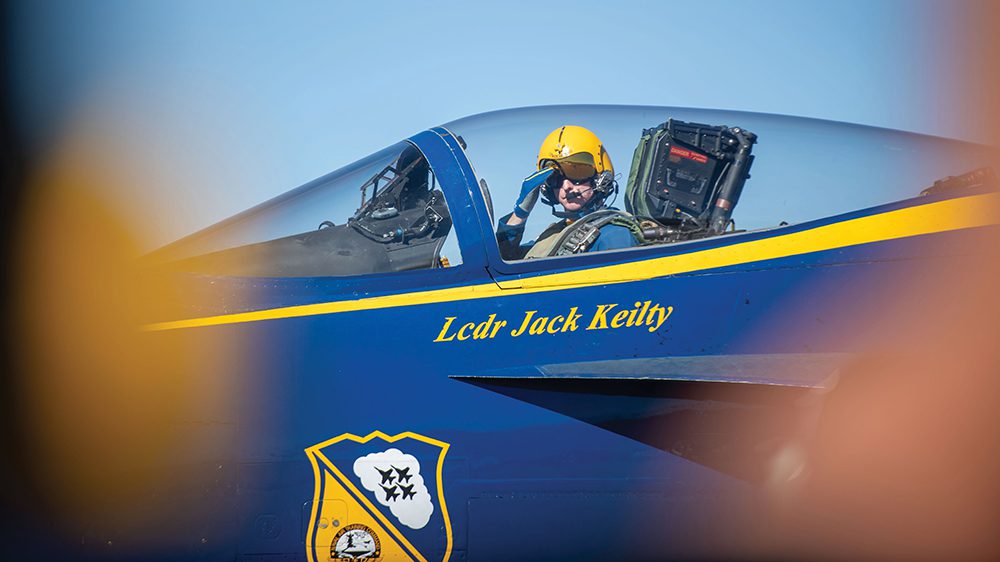

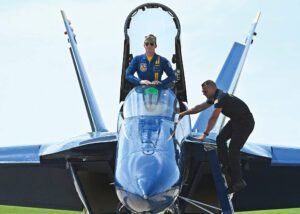 Asked why he persisted, Keilty said, “VMI has an amazing history, and its alumni have made significant contributions to the country. Its ROTC program was one of the most prestigious in the country. It was, as I said before, a family school. Finally, it is an experience that comprehensively challenges you, and that made it something that I knew, after graduation, I’d be proud to have done.”
Asked why he persisted, Keilty said, “VMI has an amazing history, and its alumni have made significant contributions to the country. Its ROTC program was one of the most prestigious in the country. It was, as I said before, a family school. Finally, it is an experience that comprehensively challenges you, and that made it something that I knew, after graduation, I’d be proud to have done.”

